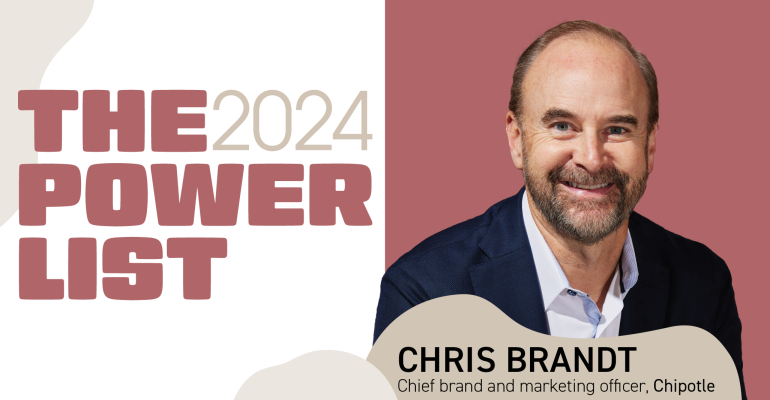Chipotle has flexed its marketing muscle for years, jumping into new channels like BeReal and the metaverse before they’re proven out, evolving its popular rewards programs with exclusive programs like “Freepotle,” and forging partnerships with brands like Street Fight 6. This prowess is why Chris Brandt, chief brand officer, is worthy of the Power List.
Under his leadership, the company has cracked the marketing code, no doubt. But even he admits the influencer landscape has made things a bit more challenging. That said, it also provides more opportunities. Consider last year’s campaign with TikTok creators Keith Lee and Alexis Frost, for instance. The chain brought their wildly popular menu hacks to life on the menu and generated record-setting digital sales in the process.
While this is one of many success stories from the brand’s marketing department, the staggering growth of influencers, and the creator economy in general, has added another ball to an already dizzying juggling act.
“I think the CMO job in this face of fragmentation is a little bit like an orchestra conductor, and the first thing you do is hire really good people who know these spaces and can dive deep,” Brandt said. “But it starts at the top of your strategy. We have a very clear idea of what we want to do for the brand. We want to be more visible, more relevant. That’s the mandate we had when I started and that we still have today.”
Brandt started at Chipotle in 2018. The influencer piece has played a role for the brand since, but last year it reached a fever pitch with the Lee/Frost partnership. The two of them combined have nearly 19 million followers on TikTok, but Chipotle also identifies influencers with a much smaller following base and geographic coverage. The criteria to work with the brand is straightforward.
“They absolutely must be a Chipotle fan first. We have a screening process for that. A lot of people we work with have talked about Chipotle already, and that’s how we find them,” Brandt said. “I don’t have any interest in trying to convince somebody who’s not a Chipotle person to be a Chipotle person.”
That screening process includes asking them what their favorite order is. If they just say a chicken burrito, they may not resonate as much as if they hypothetically go down a line and add ingredients intuitively, Brandt said. These people, he adds, are more authentic, more organic. “It feels more genuine,” he said, pointing to an example from the company’s #ChipotleSponsorMe TikTok challenge from 2020, in which five winners received a Chipotle celebrity card.
“Creating their own kind of Chipotle content is amazing,” he said. “We’re constantly looking for the intersection of culture and Chipotle, and sometimes those influencers might be it.”
That intersection, or what he calls the “cultural zeitgeist,” is where Chipotle focuses its strategy most.
“Our philosophy is trying to find people that are true Chipotle fans. Do they fit the brand? What are they talking about? Are they culturally relevant?” Brandt said.
One of the biggest challenges, he adds, is handing them the keys to the content, which is why it’s important to really know your partners and have some guardrails in place.
“You have to experiment and have an innovative mindset to know some things are going to work really well and some are maybe not going to, and that’s OK. You just learn and move on,” he said.
Brandt notes that while we’re talking about — and prioritizing — influencers more, the concept certainly isn’t new. In fact, he recalls discussing how to fit them into a strategy in 2012-13, when he was the CMO of Taco Bell.
“All of a sudden, they’re becoming a huge deal and could start to move culture, and we’ve evolved all the way to now they’re moving product,” Brandt said. “And they have a lot of people who listen to them and do what they say. How do we harness that? Part of that is embracing that they know their audience and what resonates with them.”
Therein lies the true impact of Chipotle’s influencer strategy. It’s evolved from moving culture to moving product. Still, despite the growth of the creator economy, Brandt said it’s important to strike a balance between co-creation and Chipotle’s broader marketing strategy. The key, he said, is making sure those influencers aren’t just being a shill that sells the product they’re trying to move. That’s when it becomes less valuable; customers will pick up on that right away, Brandt said.
“You have to find the right people that you trust, and it has to work in tandem with everything else,” he said. “Our TV advertising drives massive reach. Our digital piece can target people. Our organic social is huge. Our loyalty program has 39 million people. All of those things are competing to see where we get the best return. The fortunate thing for us is, as we grow, our marketing budget grows, too.
“But it’s important to understand (influencers) are going to be a part of that mix,” he added, “and it’s here to stay.”
So, what’s next with that growing budget? More conversations, more products brought back at the request of consumers (the recent return of the Chicken al Pastor is an example of this), and more listening to ensure the company is ready to strike while the cultural iron is hot.
“Back in the old days, it was easy. You bought a 30-second TV spot, and you reached half the country. Now it's a two-way street. You’re constantly monitoring what’s relevant,” Brandt said. “People don’t hate advertising. They hate advertising that isn’t relevant to them. So our quest is to always give them things that are relevant. If we do that, we’re much more of a welcomed guest than an intrusion.”
Contact Alicia Kelso at [email protected]

